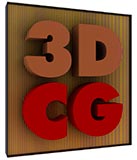
3D/CG Ronald Davis
Three Dimensional Computer Graphics: 2004–07
Eight Modern, Santa Fe, NM
November 16, 2007 – December 31, 2007
CATALOG
VIEW the .pdf version of the catalog
Richard Tobin, THE Magazine, April 01, 2008
Opticality is paramount: students of photography no doubt can point to a particular moment in the history of the medium – say Stieglitz’s Photo-Secession group exhibition at the Albright Art Gallery in 191O – when photography achieved de jure recognition by a museum as a legitimate art form – not unlike the arrival of Modern Art in America with the Armory Show of 1913. What is less easy to pinpoint is the more likely earlier scenario wherein artists' use of the medium argued for its de facto acceptance as art. Digital Imaging is by now a familiar component in installation, video, and multimedia pieces. But computer graphics, pace "Lord of the Rings,” has yet to have its own moment indicating that digital imaging has finally "arrived" – that, at its best, it occupies its own niche as an art form in today's pluralist scene.
When it does arrive, a 20-20 hindsight history of digital art will have to reserve a seminal role for Ronald Davis in the elevation of computer graphics to whatever we're calling serious art in post post-modern times. Davis's comments in the artist statement accompanying his recent show at Eight Modem covers all the salient points of his art: "My work is comprised of aggressively decorative, meaningless, unidentified floating objects that pretend to be rational. Illusion is my vehicle. Opticality is paramount."
“Aggressively Decorative” means that Davis's high-end graphics make no concession to the contemporary wariness of visual appeal. The artist's objects are uncompromisingly well designed and beautiful to see. How could they be otherwise? They dwell in the algorithmic Eden of a flawless virtual geometric world that Plato's perfect forms could call home, where they possess a quality of color whose purity, saturation, and range are unmatched in any other medium.
Davis's dedication to 3-D rendering can be compared to Uccello's passion for perspective. The artist's own characterization of his work as "unidentified floating objects that pretend to be rational" is as good a definition of Renaissance illusion as any we're likely to find. "Pretend" is the trompe in trompe I'oeil. And we willingly suspend our disbelief because the geometric illusion we embrace is a supremely rational heresy – the virtual grid is always there to catch us.
Yet however reassuring for the viewer, the mathematical certitude and geometric precision of computer graphics do not relieve the composer – here the artist – of responsibility for aesthetic choices. Davis makes apt analogies between the materials and techniques of traditional painting and the digital tools of graphic imaging. His recourse to modeling, texturing, and rendering software with a mouse and a keyboard requires the same artistic decision making as a traditional painter's deployment of conventional perspective, modeling, brushwork, and finishing of the painted surface. If the comparison breaks down on formal grounds, it breaks in favor of the digital image. Its technology enables the artist to realize desired qualities of color and light at a level far superior to what can be achieved with hand-applied techniques and organic, volatile, and perishable mediums.
Perhaps the one disingenuous or droll aspect of Davis's statement is his characterization of his digital objects as "meaningless." What he is likely saying here is that the intent of his work is not driven by some post-minimal or demi-deconstructionist theory, a residue of late seventies and eighties art discourse that still supplies the heavy lifting for a lot of contemporary work today. Which is not to say that the formal appeal of these pieces precludes a cerebral response. In 1980, art historian and critic Edward Lucie-Smith noted that "Davis is a complete paradox: an artist who seems to depict real objects in real space… He takes typical Minimal and neo-Constructivist Sculptural forms and makes them the pretext for illusionist exercises in two dimensions – indeed as subjects for still-life… The illusion is shown to be superior – more dynamic, more visually exciting – to the reality.
Yet the very illusion of these electronic images, juxtaposed with the virtual nature of their status as objects, invites reflection on the role of representation. Davis's recourse to digital images might appear a quantum leap from Jasper Johns's wooden ruler ready-mades in Device, but like the rulers they, too, illustrate Johns's formula for an expanded function of the readymade in depiction (A=B, A is B, A represents B – what David Joselit described in American Art since 1945 as the simultaneous functions of "image, tool, and text").
The semiology of Davis's digital images can be linked further back to Magritte's Ceci n'est pas une pipe with its trompe I'oeil conceit about the deception of imagery. And the surreally high resolution and super size scale make his Coffee Cup II an item worthy of inclusion on the same menu as Meret Oppenheim's furry breakfast setting.
Meret Oppenheim. Object. Paris 1936. Fur-covered cup, saucer, and spoon.
Museum of Modern Art, NYC

Ronald Davis, Coffee Cup, 2006
